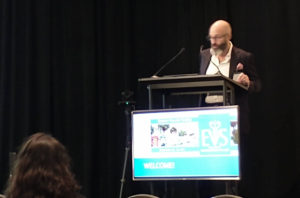
“The mantra I always use with fellows is bad vein, bad bypass.” Those were the words of Gregg Landis, MD, system chief of vascular surgery at Northwell Health in New York, as he presented an 18-year experience of polytetrafluoroethylene (PTFE) bypasses to tibial and pedal arteries for limb salvage.
Landis was responding to a comment from the floor at the Eastern Vascular Society (EVS) annual meeting (Sept. 23–26) in Charleston, South Carolina, that had pondered the utility of compromised vein bypasses and the “magic solution” to maintaining PTFE bypasses. They “rarely fail because they have a proximal stenosis or distal outflow; they just have failed whether you follow them closely or not,” the questioner said. The bypasses that fail abruptly, commented Landis, fail early. The ones that tend to stay open are seen in patients “who rarely come in.” Perhaps the early failures are down to patient-associated clinical factors, he added.
The study at hand was comprised of two parts: a single-center experience with 118 consecutive patients followed for up to five years from 2013 to 2018 at Landis’ own institution and 32 bypasses derived from five institutions. Among the single-center group, a large percentage were still active smokers at the time of their bypass, Landis pointed out.
Further, 64% of the cases received a direct-to-artery anastomosis, while 36% had a vein patch. Landis showed that bypass patency was 69% at one year and 40% out to five years, while the corresponding limb salvage rates were 72% and “a very, very respectable 53%.” Twenty-one patients required reinterventions to maintain graft patency and limb salvage.
In terms of the multicenter group of patients, Landis explained that the research team looked at patients who had ultra-long-term patency, amassing 32 patients who all had “angiographically proven patency.” Patency ranged from four to 13 years, with a mean of almost six years and many requiring multiple reinterventions, he said.
“Despite their poor current reputation, PTFE crural bypasses are worthwhile for patients facing imminent amputation without other therapeutic options. Mid-, long-, and ultra-long-term patency and limb salvage for such grafts are often achievable,” Landis and colleagues concluded.
Designated discussant Philip Paty, MD, of Vascular Health Partners of Community Care Physicians, in Glens Falls, New York, placed the findings into context, saying: “For critical limb ischemia, autogenous single-piece greater saphenous vein is the conduit of choice for bypass. Sometimes, major leg amputation is the only reasonable option in the compromised patient. But before this point, most of us would agree that, do we use either interventional techniques, or non-autogenous conduits to obtain salvage?”
Previous papers, Paty continued, have shown that patency of prosthetic bypasses, “although poor, are still attended by limb salvage.” In the PREVENT III trial, one-year patency of single-vein greater saphenous vein was 61%, he elaborated. “Has prothetic bypass evolved to explain these improved patency results?” Paty asked. Landis said he did not believe PTFE bypasses have evolved greatly, but rather his data exhibits the efficacy of old technology allied with a “fairly aggressive approach toward surveillance.”
Another question from the floor queried what appeared to be the “cherry-picked” nature of the multicenter group of patients. Landis agreed, explaining the difficulty in obtaining decade-long-type cases. “But I think the common theme in all of these patients was the aggressive approach toward reintervention,” he said.











